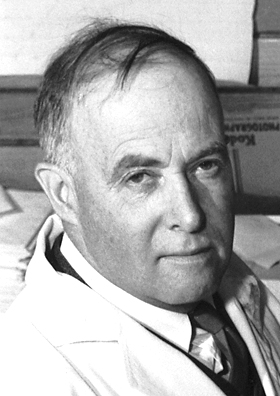James B. Sumner facts for kids
Quick facts for kids
James B. Sumner
|
|
|---|---|
 |
|
| Born | November 19, 1887 |
| Died | August 12, 1955 (aged 67) Buffalo, New York, USA
|
| Nationality | American |
| Alma mater | Harvard University |
| Known for | First to isolate an enzyme in crystallized form First to show that an enzyme is a protein |
| Awards | Nobel Prize in Chemistry (1946) |
| Scientific career | |
| Fields | Chemistry |
| Institutions | Mount Allison University, Cornell University |
| Doctoral advisor | Otto Folin |
| Doctoral students | Alexander Dounce |
James Batcheller Sumner (born November 19, 1887 – died August 12, 1955) was an American chemist. He made a huge discovery: he found that special tiny helpers in our bodies, called enzymes, can be turned into crystals. For this amazing work, he won the Nobel Prize in Chemistry in 1946. He shared the prize with two other scientists, John Howard Northrop and Wendell Meredith Stanley. James Sumner was also the first person to prove that enzymes are a type of building block called proteins.
About James Sumner
James Sumner was born on November 19, 1887, in a town called Canton, Massachusetts, in the USA.
When he was 17 years old, James had an accident that caused him to lose his left arm. Before this, he was left-handed. After the accident, he had to learn to do everything with his right hand. This showed how determined and strong-willed he was.
James went to Harvard University and earned his first degree in 1910. He met many important chemists there. After working for a short time, he became a teacher at Mount Allison University in Canada.
In 1912, he decided to study biochemistry at Harvard Medical School. Biochemistry is the study of the chemistry of living things. He earned his Ph.D. degree in 1914. After that, he started working as a professor at Cornell Medical School in New York. James Sumner had children, including four with his first wife, Cid Ricketts.
His Amazing Research
In 1917, while at Cornell, James Sumner started a very difficult project. He wanted to get enzymes into a pure form, which had never been done before. Enzymes are like tiny tools in our bodies that help chemical reactions happen, like digesting food.
He chose to work with an enzyme called urease, which he found in jack beans. For many years, his work was very hard, and some of his friends thought it was impossible. But James didn't give up!
In 1926, he finally succeeded! He showed that urease could be separated and turned into crystals. He did this by mixing the urease with a chemical called acetone and then making it very cold. This cold mixture created pure, crystallized urease.
He also used chemical tests to prove that his pure urease was a protein. This was a huge discovery because, at the time, scientists weren't sure if enzymes were proteins. James Sumner's work proved they were!
Because of his successful research, he became a full professor at Cornell in 1929. His laboratory was in Stocking Hall, where he did his Nobel Prize-winning work. In 1937, he managed to isolate and crystallize another enzyme called catalase.
Around this time, other scientists, like John Howard Northrop, also started crystallizing enzymes. It became clear that James Sumner had found a general way to crystallize enzymes. His work helped scientists understand that all enzymes are proteins.
Awards and Recognition
In 1937, James Sumner received a special award called a Guggenheim Fellowship. He spent five months in Sweden, working with another famous scientist, Professor Theodor Svedberg. That same year, he also won the Scheele Award in Stockholm.
In 1946, James Sumner, along with John Howard Northrop and Wendell M. Stanley, shared the famous Nobel Prize for their work on crystallizing enzymes.
After winning the Nobel Prize, in 1947, James Sumner became the director of Cornell's enzyme chemistry laboratory. He was also chosen to be a member of the National Academy of Sciences in 1948 and a Fellow of the American Academy of Arts and Sciences in 1949.
Later Life
James Sumner passed away from cancer in Buffalo, New York, on August 12, 1955. He was 67 years old. His important discoveries changed how scientists understood enzymes and proteins forever.
See also
 In Spanish: James Batcheller Sumner para niños
In Spanish: James Batcheller Sumner para niños

